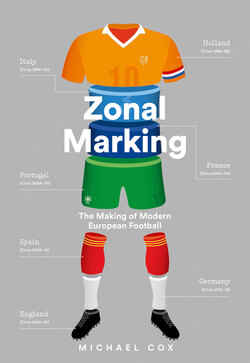Zonal Marking

Реклама. ООО «ЛитРес», ИНН: 7719571260.
Оглавление
Michael Cox. Zonal Marking
Copyright
Contents
Introduction
1. Individual versus Collective
2. Space
3. Playing Out from the Back
Transition: Netherlands–Italy
4. Flexibility
5. The Third Attacker
6. Catenaccio
Transition: Italy–France
7. Speed
8. The Number 10
9. The Water Carrier
Transition: France–Portugal
10. Structure
11. The First Port of Call
12. Wingers
Transition: Portugal–Spain
13. Tiki-taka
14. False 9s & Argentines
15. El Clásico
Transition: Spain–Germany
16. Verticality
17. Gegenpressing
18. Reinvention
Transition: Germany–England
19. The Mixer
Epilogue
Bibliography
Acknowledgements
List of Searchable Terms
Also by Michael Cox
About the Publisher
Отрывок из книги
List of Pagesiiiivviiviiiix134567891011121314151617181920212223242526272829303132333435363738394041424344454647484950515253545556575859616263646566676869707172737475767778798081828384858687888990919293949596979899100101102103104105106107108109110111112113114115116117118119120121122123124125126127129130131132133134135136137138139140141142143144145146147148149150151152153154155156157158159160161162163164165166167168169170171172173174175176177178179180181182183184185187188189190191192193194195196197198199200201202203204205206207208209210211212213214215216217218219220221222223224225226227228229230231232233234235236237238239240241242243245246247248249250251252253254255256257258259260261262263264265266267268269270271272273274275276277278279280281282283284285286287288289290291292293294295296297298299300301302303304305306307308309310311312313314315317319320321322323324325326327328329330331332333334335336337338339340341342343344345346347348349350351352353354355356357358359360361362363364365366367368369370371372373374375376377378379380381382383385387388389390391392393394395396397398399400401402403404405406407408409410411412413414415416417418419420421422423424425426427428429430431432433434435436ii
.....
On the European stage their most memorable display was a 4–0 thrashing of Manchester United at Camp Nou in November 1994. Stoichkov scored the first, Romario grabbed the second, then Stoichkov dribbled forward, slipped in Romario, who backheeled a return pass for Stoichkov to smash in the third. Full-back Albert Ferrer rounded off the scoring. ‘We just couldn’t handle the speed of Stoichkov and Romario,’ admitted United manager Alex Ferguson. ‘The suddenness with which they attacked was a new experience.’ But for Barcelona fans the 5–0 thrashing of Real Madrid earlier that year meant more. Romario hit a hat-trick, including an opener featuring him outwitting Real centre-back Rafael Alkorta with an incredible move that became known as ‘the cow’s tail’: receiving the ball with his back to goal, then turning on the spot by touching the ball twice in one movement, dragging it around into his path and finishing. ‘It will go down in history,’ said Stoichkov, referring to Romario’s move when he could have been speaking about the scoreline. But Barca were hugely inconsistent at this point, and only an excellent late run meant they pinched the title from Deportivo on goal difference, the second straight season they’d triumphed courtesy of a rival slipping up on the final day. That wasn’t, in itself, disastrous – but a 4–0 loss to Milan in the 1994 European Cup Final was.
Things started to fall apart. Cruyff and Laudrup’s relationship had broken down, the Dane was omitted from the squad for that Milan final and his contract wasn’t renewed. He promptly imitated Cruyff’s controversial switch to Feyenoord in 1983, joining Real Madrid and inspiring them to the league title while Cruyff, intriguingly, claimed Laudrup had become too individualistic. ‘He lacked discipline,’ Cruyff protested. ‘If you have a lot of stars in a team, there has to be a limit as to what each does as an individual.’ This was something of a curious explanation, though, considering that Laudrup was evidently a selfless player who loved assisting others. The reality was that Barcelona simply now had brighter stars, and with the three-foreigner rule still in place, Laudrup had become fourth in the pecking order behind Romario, Stoichkov and centre-back Ronald Koeman.
.....